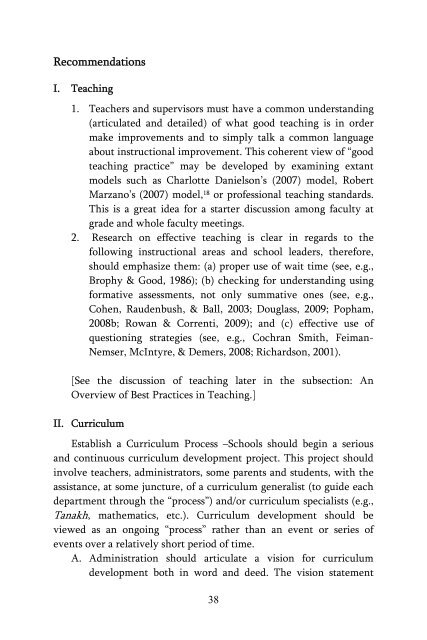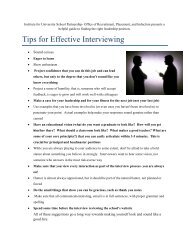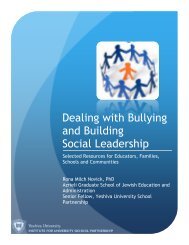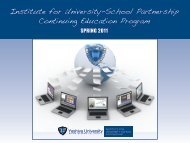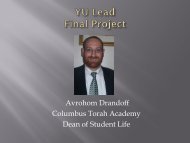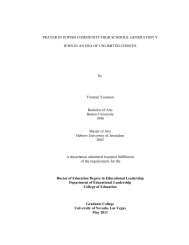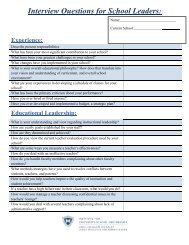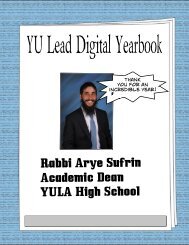RecommendationsI. Teach<strong>in</strong>g1. Teachers <strong>and</strong> supervisors must have a common underst<strong>and</strong><strong>in</strong>g(articulated <strong>and</strong> detailed) of what good teach<strong>in</strong>g is <strong>in</strong> ordermake improvements <strong>and</strong> to simply talk a common languageabout <strong>in</strong>structional improvement. This coherent view of “goodteach<strong>in</strong>g practice” may be developed by exam<strong>in</strong><strong>in</strong>g extantmodels such as Charlotte Danielson’s (2007) model, RobertMarzano’s (2007) model, 18 or professional teach<strong>in</strong>g st<strong>and</strong>ards.This is a great idea for a starter discussion among faculty atgrade <strong>and</strong> whole faculty meet<strong>in</strong>gs.2. Research on effective teach<strong>in</strong>g is clear <strong>in</strong> regards to thefollow<strong>in</strong>g <strong>in</strong>structional areas <strong>and</strong> school leaders, therefore,should emphasize them: (a) proper use of wait time (see, e.g.,Brophy & Good, 1986); (b) check<strong>in</strong>g for underst<strong>and</strong><strong>in</strong>g us<strong>in</strong>gformative assessments, not only summative ones (see, e.g.,Cohen, Raudenbush, & Ball, 2003; Douglass, 2009; Popham,2008b; Rowan & Correnti, 2009); <strong>and</strong> (c) effective use ofquestion<strong>in</strong>g strategies (see, e.g., Cochran Smith, Feiman-Nemser, McIntyre, & Demers, 2008; Richardson, 2001).[See the discussion of teach<strong>in</strong>g later <strong>in</strong> the subsection: AnOverview of Best Practices <strong>in</strong> Teach<strong>in</strong>g.]II. CurriculumEstablish a Curriculum Process –<strong>Schools</strong> should beg<strong>in</strong> a serious<strong>and</strong> cont<strong>in</strong>uous curriculum development project. This project should<strong>in</strong>volve teachers, adm<strong>in</strong>istrators, some parents <strong>and</strong> students, with theassistance, at some juncture, of a curriculum generalist (to guide eachdepartment through the “process”) <strong>and</strong>/or curriculum specialists (e.g.,Tanakh, mathematics, etc.). Curriculum development should beviewed as an ongo<strong>in</strong>g “process” rather than an event or series ofevents over a relatively short period of time.A. Adm<strong>in</strong>istration should articulate a vision for curriculumdevelopment both <strong>in</strong> word <strong>and</strong> deed. The vision statement38
should <strong>in</strong>clude goal sett<strong>in</strong>g strategies <strong>and</strong> a timel<strong>in</strong>e. It issuggested that dur<strong>in</strong>g the first year, beg<strong>in</strong>n<strong>in</strong>g perhaps overthe summer (many schools beg<strong>in</strong> their curriculum plann<strong>in</strong>g atthe end of the school year <strong>and</strong>/or dur<strong>in</strong>g the summer with theavailability of grants to support such efforts), form<strong>in</strong>gcommittees, outl<strong>in</strong><strong>in</strong>g goals <strong>and</strong> objectives, etc. The first yearshould <strong>in</strong>volve the plann<strong>in</strong>g process, with the second yeargradually <strong>in</strong>itiat<strong>in</strong>g implementation of changes. Best practices<strong>in</strong> the curriculum literature demonstrate that a slower processbuilds a culture of learn<strong>in</strong>g thus susta<strong>in</strong><strong>in</strong>g the curriculumdevelopment <strong>in</strong> an ongo<strong>in</strong>g fashion. Clearly, benchmarks <strong>and</strong>measurable outcomes should be established to ensure progressis be<strong>in</strong>g made, goals reached, etc. Curriculum <strong>in</strong> many schoolsdepends too much on the “particular” teacher; alignment ofcurriculum is necessary so that all teachers (<strong>and</strong> new ones, <strong>in</strong>particular) would receive a formal curriculum to guide them,while still allow<strong>in</strong>g for <strong>in</strong>dividual <strong>in</strong>put <strong>and</strong> creativity.B. Adm<strong>in</strong>istration must set aside time for curriculum committeesto meet on an ongo<strong>in</strong>g basis. Incentives, if possible at no orlow cost, should be offered to active participants (e.g., releasetime, an extra day off, etc.)C. A curriculum consultant can assist the school with the“curriculum mapp<strong>in</strong>g” process. A UbD (Underst<strong>and</strong><strong>in</strong>g byDesign) approach to curriculum development (Wigg<strong>in</strong>s &McTighe, 2005) is recommended because it is particularlyuseful <strong>in</strong> Judaic studies. The “Paideia Proposal” (Adler, 1982)is also s<strong>in</strong>gularly well-suited for limmudei kodesh curriculas<strong>in</strong>ce it allows one to beg<strong>in</strong> the process by stipulat<strong>in</strong>g the textat the focus of the learn<strong>in</strong>g, elaborat<strong>in</strong>g on the acquisition ofskills <strong>and</strong>, f<strong>in</strong>ally, the enlarged underst<strong>and</strong><strong>in</strong>g of ideas <strong>and</strong>values.D. Even when State st<strong>and</strong>ards exist <strong>in</strong> secular studies, ongo<strong>in</strong>gcurriculum development is necessary (e.g., alignment ofst<strong>and</strong>ards to lessons, revision of st<strong>and</strong>ards to meet local goals<strong>and</strong> objectives, etc.). Therefore, when a school official says“we don’t need curriculum development because we use State39
- Page 1 and 2: Improving InstructionalQuality in J
- Page 4 and 5: Appendix C: Assessing Your Role as
- Page 6 and 7: others, involved in a cognate enter
- Page 8 and 9: Weissberg, Walberg, & Wang., 2004).
- Page 10 and 11: all. “We are never asked for what
- Page 12 and 13: administrator. He was well-organize
- Page 14 and 15: Sartoris, DiPrima Bickel, & Garnier
- Page 16 and 17: grade conferences, etc., effective
- Page 18 and 19: school’s teaching practices, the
- Page 20 and 21: een made in the areas of science an
- Page 22 and 23: learning is more likely to occur th
- Page 24 and 25: content, and the need to ensure tha
- Page 26 and 27: pattern.] I didn’t really realize
- Page 28 and 29: constraints, increase in administra
- Page 30 and 31: The Transformational Change Project
- Page 32 and 33: that are not strategic, but episodi
- Page 34 and 35: my personal involvement in work wit
- Page 36 and 37: schools to even greater levels of s
- Page 38 and 39: was: “Well, you know, finding tim
- Page 40 and 41: called direct teaching), although e
- Page 42 and 43: surprised when no one can answer
- Page 46 and 47: standards,” a significant opportu
- Page 48 and 49: decide on an area or theme they’d
- Page 50 and 51: • Reflective journaling - Another
- Page 52 and 53: 3. Deep instructional improvement v
- Page 54 and 55: Instructional leadership is about e
- Page 56 and 57: 76). Teachers who employ instructio
- Page 58 and 59: short answers to two questions. The
- Page 60 and 61: may become involved in cooperative
- Page 62 and 63: utilized within a differentiated le
- Page 64 and 65: Research-Based Teaching Practices i
- Page 66 and 67: curriculum? Schools, in my view, to
- Page 68 and 69: learning objectives have been ident
- Page 70 and 71: Developing curriculum at the planni
- Page 72 and 73: 4) Emphasize both the academic and
- Page 74 and 75: An Overview of Best Practices in Su
- Page 76 and 77: with practices best suited to promo
- Page 78 and 79: dialogue and meaningful supervision
- Page 80 and 81: • Ongoing - Too much of professio
- Page 82 and 83: to do so. In fact, utilizing in-sch
- Page 84 and 85: greatly to meaningful supervision a
- Page 86 and 87: and amplified by James MacGregor Bu
- Page 88 and 89: Leadership is predicated on the fou
- Page 90 and 91: Citing Jim Collins (2002 cited by F
- Page 92 and 93: Notes1. Before continuing, I sugges
- Page 94 and 95:
ubric of “professional developmen
- Page 96 and 97:
throughs, explains that according t
- Page 98 and 99:
members are not fully cognizant or
- Page 100 and 101:
AcknowledgementsI thank all the ind
- Page 102 and 103:
Bass, B. M. (1985). Leadership and
- Page 104 and 105:
Burke, P. J., & Krey, R. D. (2005).
- Page 106 and 107:
Downey, C. J., Steffy, B. E., Posto
- Page 108 and 109:
Fullan, M. (2005). Leadership and s
- Page 110 and 111:
Good, T., & Brophy, J. E. (2007). L
- Page 112 and 113:
Johnson, C. C., & Fargo, J. D. (201
- Page 114 and 115:
Marzano, R. J., & Brown, J. L. (200
- Page 116 and 117:
Popham, W. J. (2008a). Classroom as
- Page 118 and 119:
Shapira-Lishchinsky, O. (2009). Isr
- Page 120 and 121:
Tschannen-Moran, M., & McMaster, P.
- Page 122 and 123:
Annotated Works on Instructional Le
- Page 124 and 125:
This volume is an inspiring introdu
- Page 126 and 127:
you want to learn how to teach stud
- Page 128 and 129:
AppendicesAppendix A: Instructional
- Page 130 and 131:
Suggested responses:1. To be effect
- Page 132 and 133:
Appendix C: Assessing Your Role as
- Page 134 and 135:
SA A D SD 3. My spoken language as
- Page 136 and 137:
Domain 2: The Classroom Environment
- Page 138 and 139:
SA A D SD 13. I have a well-defined
- Page 140 and 141:
SA A D SD 13. I rarely desire to se
- Page 142 and 143:
20. This is a well managed school.
- Page 144 and 145:
Appendix F: Teacher Attitude Questi
- Page 146:
41. My colleagues and I usually dis


